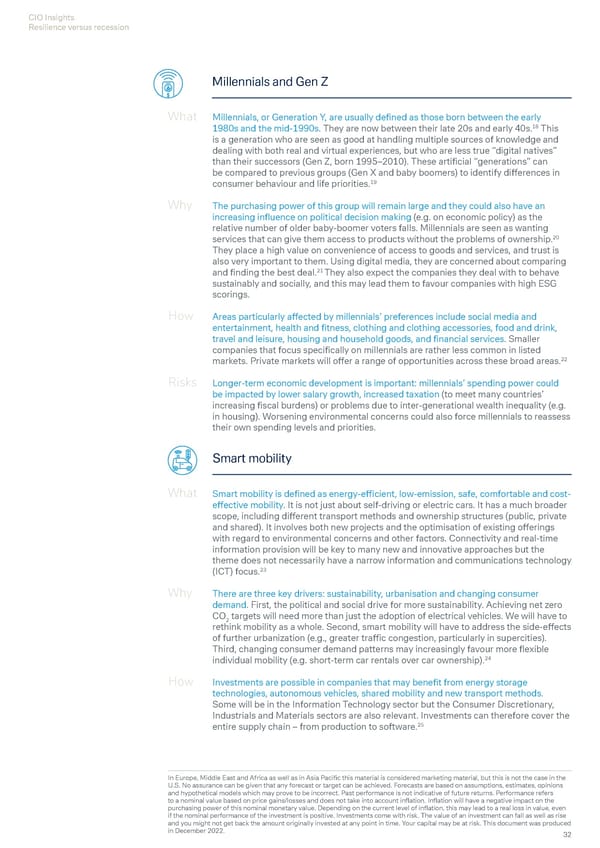CIO Insights Resilience versus recession Millennials and Gen Z What Millennials, or Generation Y, are usually defined as those born between the early 18 1980s and the mid-1990s. They are now between their late 20s and early 40s. This is a generation who are seen as good at handling multiple sources of knowledge and dealing with both real and virtual experiences, but who are less true “digital natives” than their successors (Gen Z, born 1995–2010). These artificial “generations” can be compared to previous groups (Gen X and baby boomers) to identify differences in consumer behaviour and life priorities.19 Why The purchasing power of this group will remain large and they could also have an increasing influence on political decision making (e.g. on economic policy) as the relative number of older baby-boomer voters falls. Millennials are seen as wanting 20 services that can give them access to products without the problems of ownership. They place a high value on convenience of access to goods and services, and trust is also very important to them. Using digital media, they are concerned about comparing and finding the best deal.21 They also expect the companies they deal with to behave sustainably and socially, and this may lead them to favour companies with high ESG scorings. How Areas particularly affected by millennials’ preferences include social media and entertainment, health and fitness, clothing and clothing accessories, food and drink, travel and leisure, housing and household goods, and financial services. Smaller companies that focus specifically on millennials are rather less common in listed 22 markets. Private markets will offer a range of opportunities across these broad areas. Risks Longer-term economic development is important: millennials’ spending power could be impacted by lower salary growth, increased taxation (to meet many countries’ increasing fiscal burdens) or problems due to inter-generational wealth inequality (e.g. in housing). Worsening environmental concerns could also force millennials to reassess their own spending levels and priorities. Smart mobility What Smart mobility is defined as energy-efficient, low-emission, safe, comfortable and cost- effective mobility. It is not just about self-driving or electric cars. It has a much broader scope, including different transport methods and ownership structures (public, private and shared). It involves both new projects and the optimisation of existing offerings with regard to environmental concerns and other factors. Connectivity and real-time information provision will be key to many new and innovative approaches but the theme does not necessarily have a narrow information and communications technology (ICT) focus.23 Why There are three key drivers: sustainability, urbanisation and changing consumer demand. First, the political and social drive for more sustainability. Achieving net zero CO targets will need more than just the adoption of electrical vehicles. We will have to 2 rethink mobility as a whole. Second, smart mobility will have to address the side-effects of further urbanization (e.g., greater traffic congestion, particularly in supercities). Third, changing consumer demand patterns may increasingly favour more flexible 24 individual mobility (e.g. short-term car rentals over car ownership). How Investments are possible in companies that may benefit from energy storage technologies, autonomous vehicles, shared mobility and new transport methods. Some will be in the Information Technology sector but the Consumer Discretionary, Industrials and Materials sectors are also relevant. Investments can therefore cover the entire supply chain – from production to software.25 In Europe, Middle East and Africa as well as in Asia Pacific this material is considered marketing material, but this is not the case in the U.S. No assurance can be given that any forecast or target can be achieved. Forecasts are based on assumptions, estimates, opinions and hypothetical models which may prove to be incorrect. Past performance is not indicative of future returns. Performance refers to a nominal value based on price gains/losses and does not take into account inflation. Inflation will have a negative impact on the purchasing power of this nominal monetary value. Depending on the current level of inflation, this may lead to a real loss in value, even if the nominal performance of the investment is positive. Investments come with risk. The value of an investment can fall as well as rise and you might not get back the amount originally invested at any point in time. Your capital may be at risk. This document was produced in December 2022. 32
 Deutsche Bank Economic and Investment Outlook Page 33 Page 35
Deutsche Bank Economic and Investment Outlook Page 33 Page 35